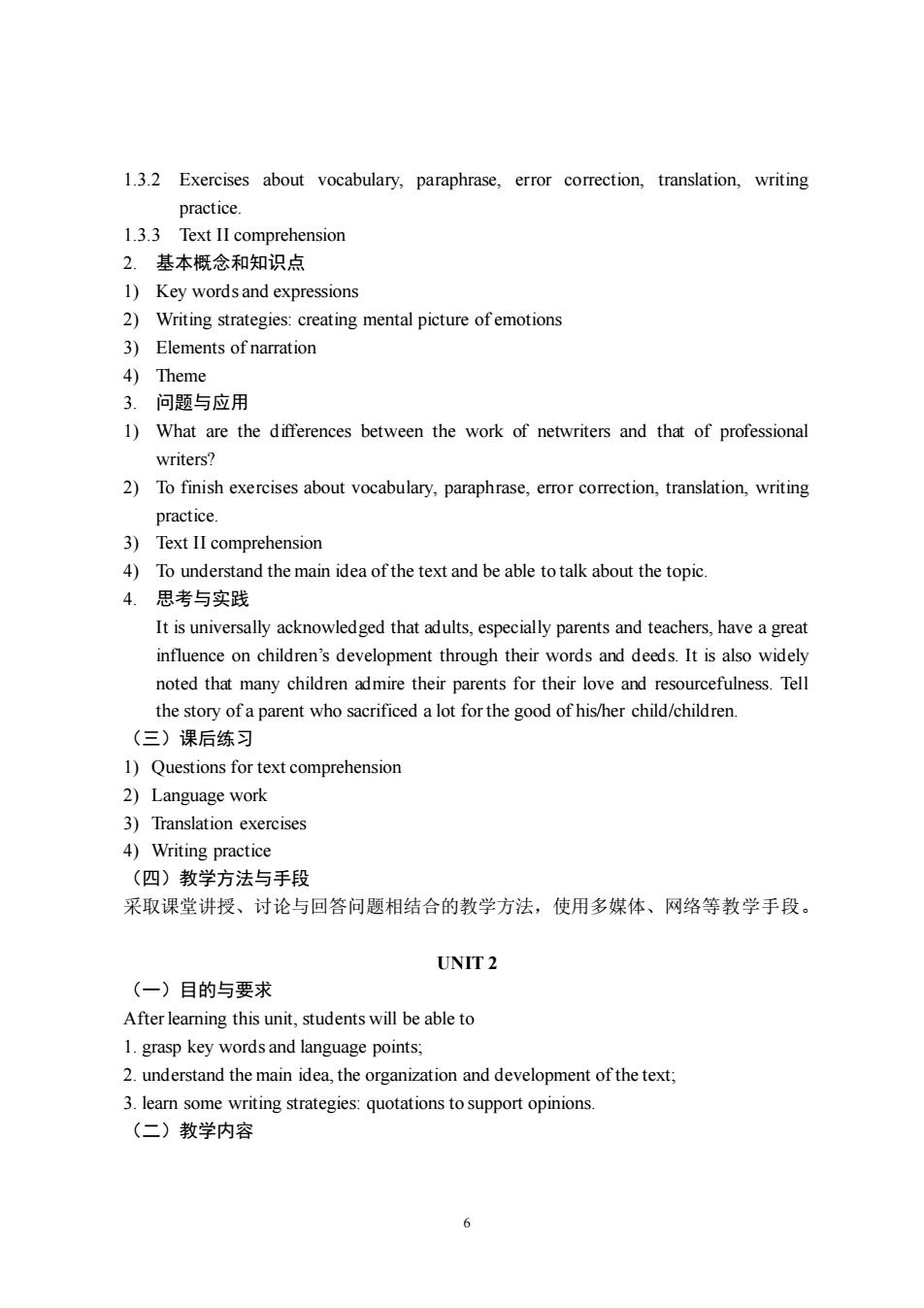
1.3.2 Exercises about vocabulary,paraphrase,error correction,translation,writing practice 1.3.3 Text II comprehension 2.基本概念和知识点 1)Key wordsand expressions 2)Writing strategies:creating mental picture of emotions 3)Elements of narration 4)Theme 3问题与应用 1)What are the differences between the work of netwriters and that of professional writers? 2)To finish exercises about vocabulary,paraphrase,error correction,translation,writing practice. 3)Text II comprehension 4)To understand the main idea of the text and be able totalk about the topic 4.思考与实践 It is universally acknowledged that adults.especially parents and teachers.have a great influence on children's development through their words and deeds.It is also widely noted that many children admire their parents for their love and resourcefulness.Tell the story of a parent who sacrificed a lot for the good of his/her child/children. (三)课后练习 1)Ouestions for text comprehension 2)Language work 3)Translation exercises 4)Writing practice (四)教学方法与手段 采取课堂讲授、讨论与回答问题相结合的教学方法,使用多媒体、网络等教学手段。 UNIT2 (一)目的与要求 After learning this unit.students will be able to 1.grasp key words and language points. 2.understand the main idea,the organization and development of the text, 3.leam some writing strategies:quotations to support opinions (二)教学内容
6 1.3.2 Exercises about vocabulary, paraphrase, error correction, translation, writing practice. 1.3.3 Text II comprehension 2. 基本概念和知识点 1) Key words and expressions 2) Writing strategies: creating mental picture of emotions 3) Elements of narration 4) Theme 3. 问题与应用 1) What are the differences between the work of netwriters and that of professional writers? 2) To finish exercises about vocabulary, paraphrase, error correction, translation, writing practice. 3) Text II comprehension 4) To understand the main idea of the text and be able to talk about the topic. 4. 思考与实践 It is universally acknowledged that adults, especially parents and teachers, have a great influence on children’s development through their words and deeds. It is also widely noted that many children admire their parents for their love and resourcefulness. Tell the story of a parent who sacrificed a lot for the good of his/her child/children. (三)课后练习 1) Questions for text comprehension 2) Language work 3) Translation exercises 4) Writing practice (四)教学方法与手段 采取课堂讲授、讨论与回答问题相结合的教学方法,使用多媒体、网络等教学手段。 UNIT 2 (一)目的与要求 After learning this unit, students will be able to 1. grasp key words and language points; 2. understand the main idea, the organization and development of the text; 3. learn some writing strategies: quotations to support opinions. (二)教学内容
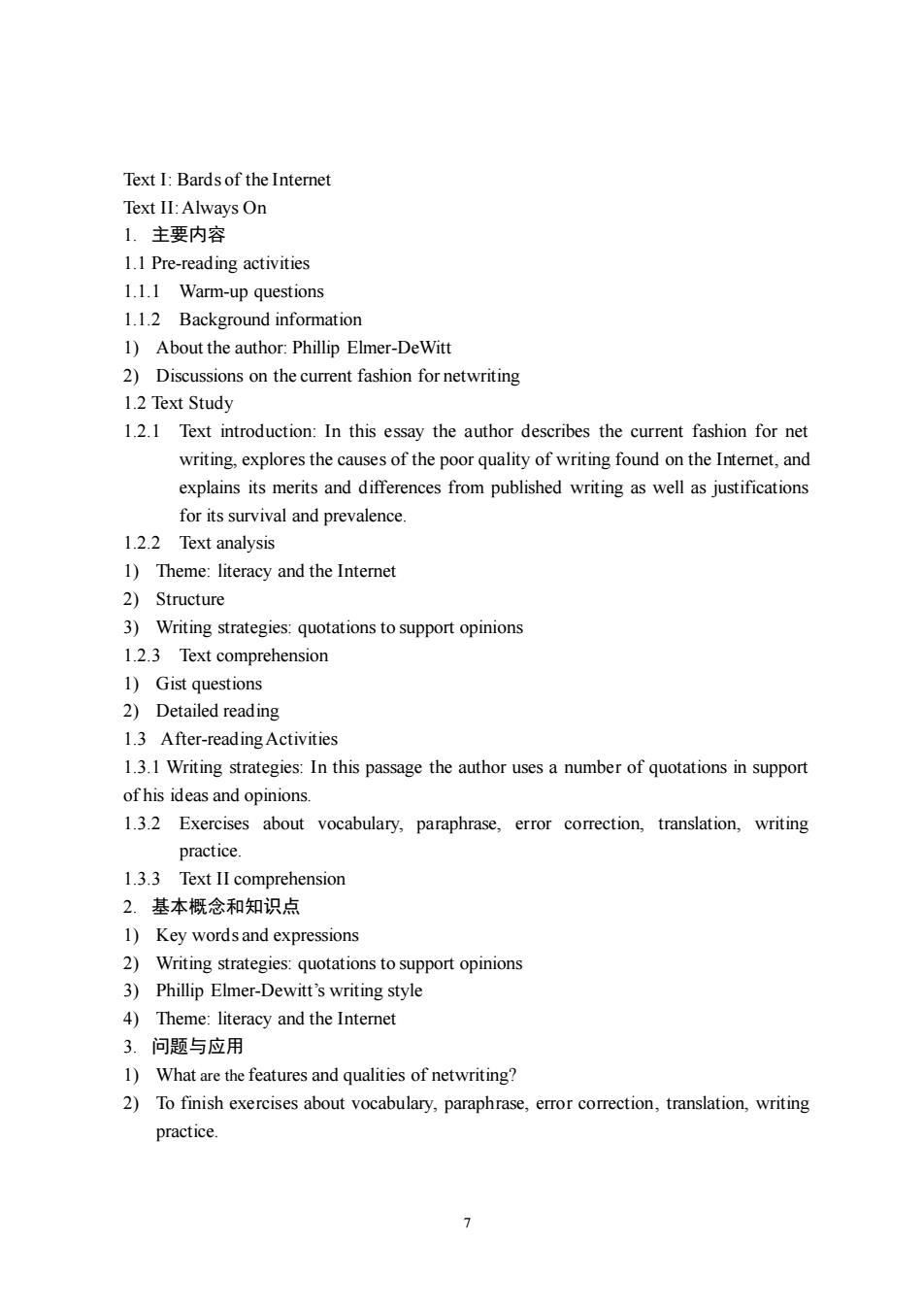
Text I:Bardsof the Internet Text II:Always On 1.主要内容 1.1Pre-reading activities 1.1.1 Warm-up questions 1.1.2 Background information 1)About the author:Phillip Elmer-DeWitt 2)Discussions on the current fashion for netwriting 12 Text Study 1.2.1 Text introduction:In this essay the author describes the current fashion for net writing,explores the causes of the poor quality of writing found on the Intemet,and explains its merits and differences from published writing as well as justifications for its survival and prevalence. 1.2.2 Text analysis 1)Theme:literacy and the Internet 2)Structure 3)Writing strategies:quotations to support opinions 1.2.3 Text comprehension 1)Gist questions 2)Detailed reading 1.3 After-readingActivities 1.3.1 Writing strategies:In this passage the author uses a number of quotations in support ofhis ideas and opinions 1.3.2 Exercises about vocabulary,paraphrase,error correction,translation,writing practice. 1.3.3 Text II comprehension 2.基本概念和知识点 1)Key wordsand expressions 2)Writing strategies:quotations to support opinions 3)Phillip Elmer-Dewitt's writing style 4)Theme:literacy and the Internet 3.问题与应用 1)What are the features and qualities of netwriting? 2)To finish exercises about vocabulary,paraphrase,error correction,translation,writing practice. 7
7 Text I: Bards of the Internet Text II: Always On 1. 主要内容 1.1 Pre-reading activities 1.1.1 Warm-up questions 1.1.2 Background information 1) About the author: Phillip Elmer-DeWitt 2) Discussions on the current fashion for netwriting 1.2 Text Study 1.2.1 Text introduction: In this essay the author describes the current fashion for net writing, explores the causes of the poor quality of writing found on the Internet, and explains its merits and differences from published writing as well as justifications for its survival and prevalence. 1.2.2 Text analysis 1) Theme: literacy and the Internet 2) Structure 3) Writing strategies: quotations to support opinions 1.2.3 Text comprehension 1) Gist questions 2) Detailed reading 1.3 After-reading Activities 1.3.1 Writing strategies: In this passage the author uses a number of quotations in support of his ideas and opinions. 1.3.2 Exercises about vocabulary, paraphrase, error correction, translation, writing practice. 1.3.3 Text II comprehension 2. 基本概念和知识点 1) Key words and expressions 2) Writing strategies: quotations to support opinions 3) Phillip Elmer-Dewitt’s writing style 4) Theme: literacy and the Internet 3. 问题与应用 1) What are the features and qualities of netwriting? 2) To finish exercises about vocabulary, paraphrase, error correction, translation, writing practice
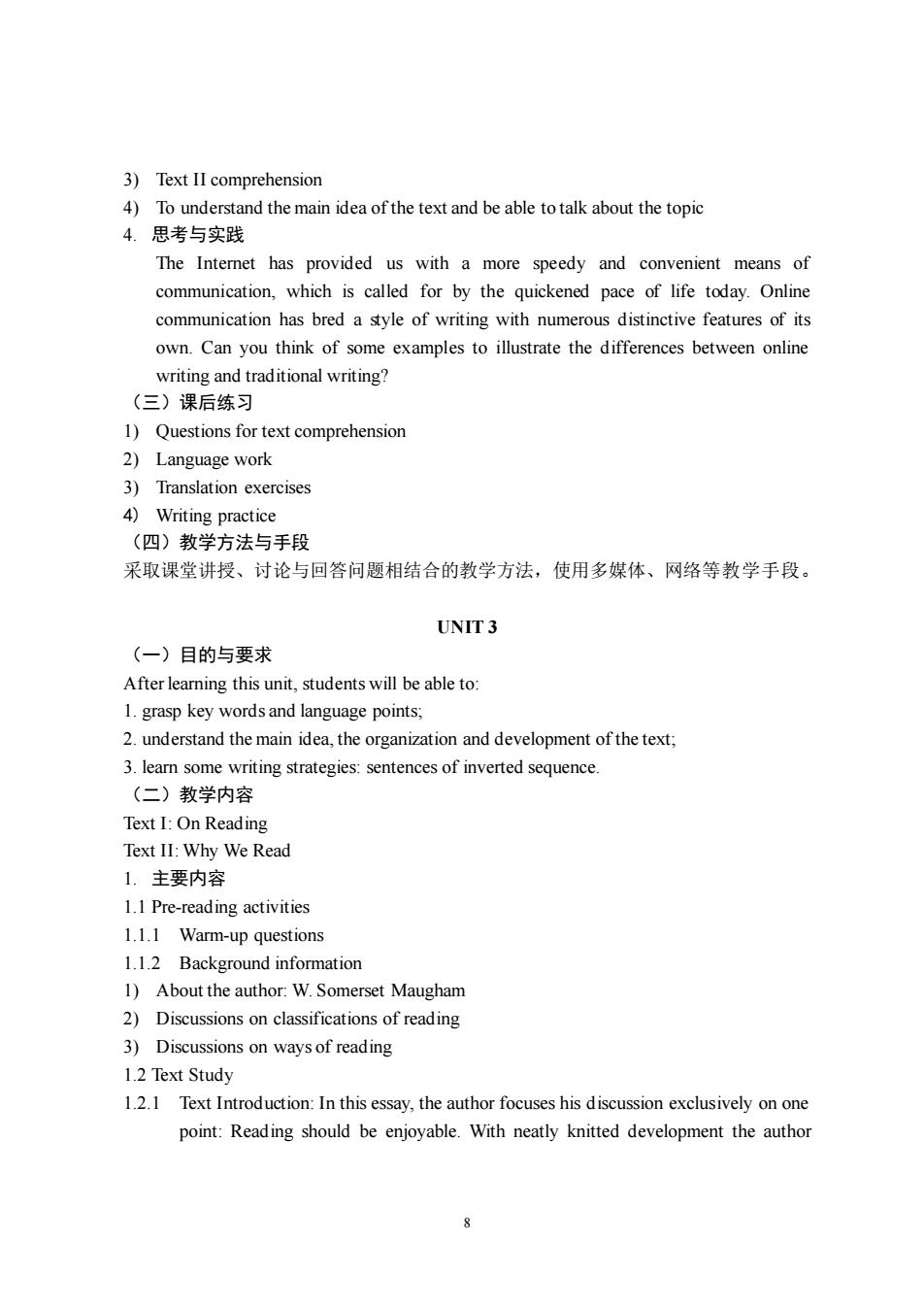
3)Text II comprehension 4)To understand the main idea of the text and be able to talk about the topic 4.思考与实践 The Internet has provided us with a more speedy and convenient means of communication,which is called for by the quickened pace of life today.Online communication has bred a style of writing with numerous distinctive features of its own.Can you think of some examples to illustrate the differences between online writing and traditional writing? (三)课后练习 1)Ouestions for text comprehension 2)Language work 3)Translation exercises 4)Writing practice (四)教学方法与手段 采取课堂讲授、讨论与回答问题相结合的教学方法,使用多媒体、网络等教学手段。 UNIT3 (一)目的与要求 After leamning this unit,students will be able to: 1.grasp key words and language points; 2.understand the main idea,the organization and development of the text: 3.learn some writing strategies:sentences of inverted sequence. (二)教学内容 Text i On reading Text II:Why We Read 1.主要内容 1.1 Pre-reading activities 1.1.1 Warm-up questions 1.1.2 Background information 1)About the author:W.Somerset Maugham 2)Discussions on classifications of reading 3)Discussions on ways of reading 1.2 Text Study 1.2.1 Text Introduction:In this essay,the author focuses his discussion exclusively on one point:Reading should be enjoyable.With neatly knitted development the author
8 3) Text II comprehension 4) To understand the main idea of the text and be able to talk about the topic 4. 思考与实践 The Internet has provided us with a more speedy and convenient means of communication, which is called for by the quickened pace of life today. Online communication has bred a style of writing with numerous distinctive features of its own. Can you think of some examples to illustrate the differences between online writing and traditional writing? (三)课后练习 1) Questions for text comprehension 2) Language work 3) Translation exercises 4) Writing practice (四)教学方法与手段 采取课堂讲授、讨论与回答问题相结合的教学方法,使用多媒体、网络等教学手段。 UNIT 3 (一)目的与要求 After learning this unit, students will be able to: 1. grasp key words and language points; 2. understand the main idea, the organization and development of the text; 3. learn some writing strategies: sentences of inverted sequence. (二)教学内容 Text I: On Reading Text II: Why We Read 1. 主要内容 1.1 Pre-reading activities 1.1.1 Warm-up questions 1.1.2 Background information 1) About the author: W. Somerset Maugham 2) Discussions on classifications of reading 3) Discussions on ways of reading 1.2 Text Study 1.2.1 Text Introduction: In this essay, the author focuses his discussion exclusively on one point: Reading should be enjoyable. With neatly knitted development the author
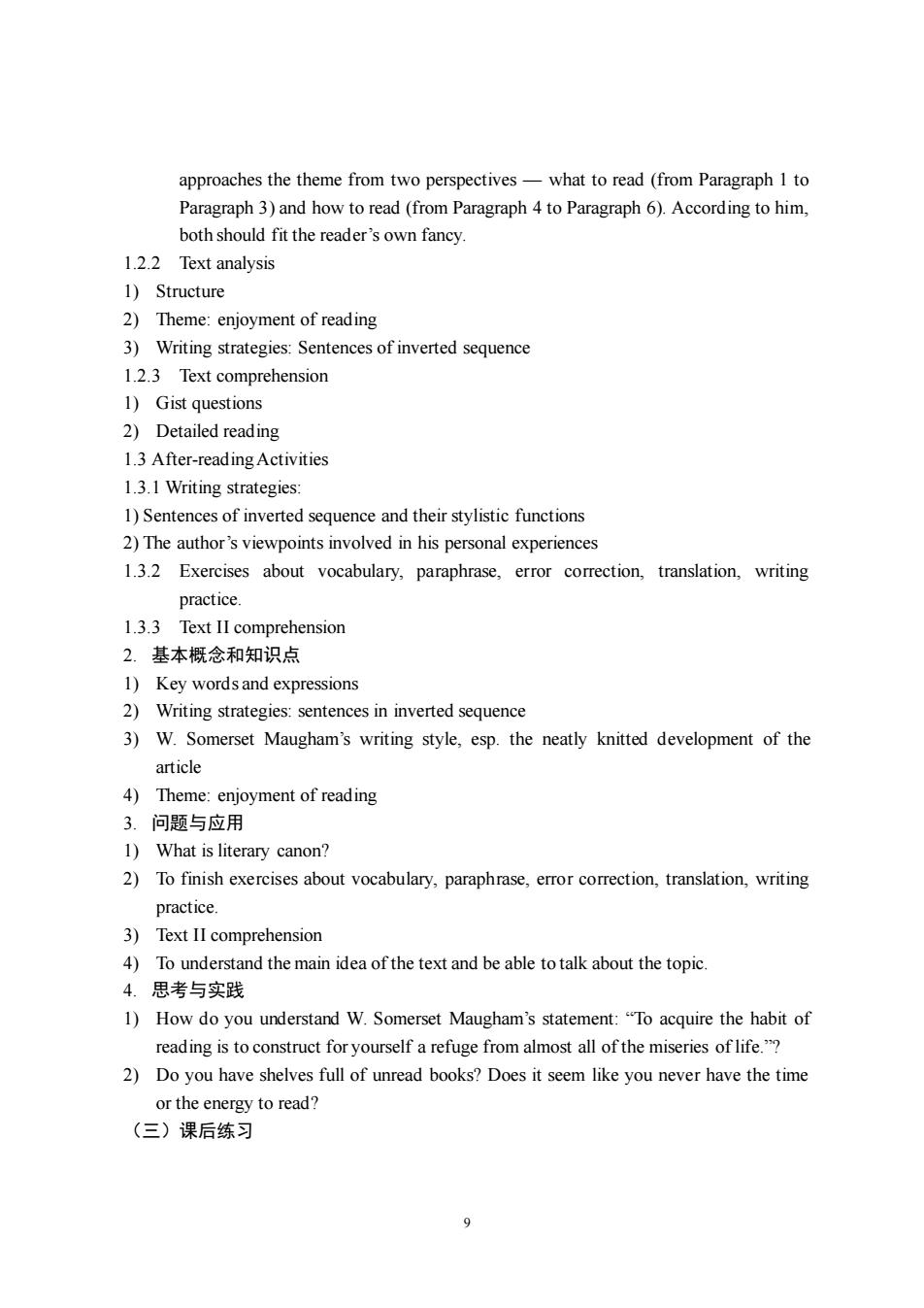
approaches the theme from two perspectives-what to read(from Paragraph I to Paragraph 3)and how to read(from Paragraph 4 to Paragraph 6).According to him, both should fit the reader's own fancy. 1.2.2 Text analysis 1)Structure 2)Theme:enjoyment of reading 3)Writing strategies:Sentences of inverted sequence 1.2.3 Text comprehension 1)Gist questions 2)Detailed reading 1.3 After-reading Activities 1.3.1 Writing strategies: 1)Sentences of inverted sequence and their stylistic functions 2)The author's viewpoints involved in his personal experiences 1.3.2 Exercises about vocabulary,paraphrase,error correction,translation,writing practice. 1.3.3 Text II comprehension 2.基本慨念和知识点 1)Key words and expressions 2)Writing strategies:sentences in inverted sequence 3)W.Somerset Maugham's writing style,esp.the neatly knitted development of the article 4)Theme:enjoyment of reading 3.问题与应用 1)What is literary canon? 2)To finish exercises about vocabulary,paraphrase,error correction,translation,writing practice. 3)Text II comprehension 4)To understand the main idea of the text and be able to talk about the topic. 4.思考与实践 1)How do you understand W.Somerset Maugham's statement:"To acquire the habit of reading is to construct for yourself a refuge from almost all of the miseries of life." 2)Do you have shelves full of unread books?Does it seem like you never have the time or the energy to read? (三)课后练习
9 approaches the theme from two perspectives — what to read (from Paragraph 1 to Paragraph 3) and how to read (from Paragraph 4 to Paragraph 6). According to him, both should fit the reader’s own fancy. 1.2.2 Text analysis 1) Structure 2) Theme: enjoyment of reading 3) Writing strategies: Sentences of inverted sequence 1.2.3 Text comprehension 1) Gist questions 2) Detailed reading 1.3 After-reading Activities 1.3.1 Writing strategies: 1) Sentences of inverted sequence and their stylistic functions 2) The author’s viewpoints involved in his personal experiences 1.3.2 Exercises about vocabulary, paraphrase, error correction, translation, writing practice. 1.3.3 Text II comprehension 2. 基本概念和知识点 1) Key words and expressions 2) Writing strategies: sentences in inverted sequence 3) W. Somerset Maugham’s writing style, esp. the neatly knitted development of the article 4) Theme: enjoyment of reading 3. 问题与应用 1) What is literary canon? 2) To finish exercises about vocabulary, paraphrase, error correction, translation, writing practice. 3) Text II comprehension 4) To understand the main idea of the text and be able to talk about the topic. 4. 思考与实践 1) How do you understand W. Somerset Maugham’s statement: “To acquire the habit of reading is to construct for yourself a refuge from almost all of the miseries of life.”? 2) Do you have shelves full of unread books? Does it seem like you never have the time or the energy to read? (三)课后练习
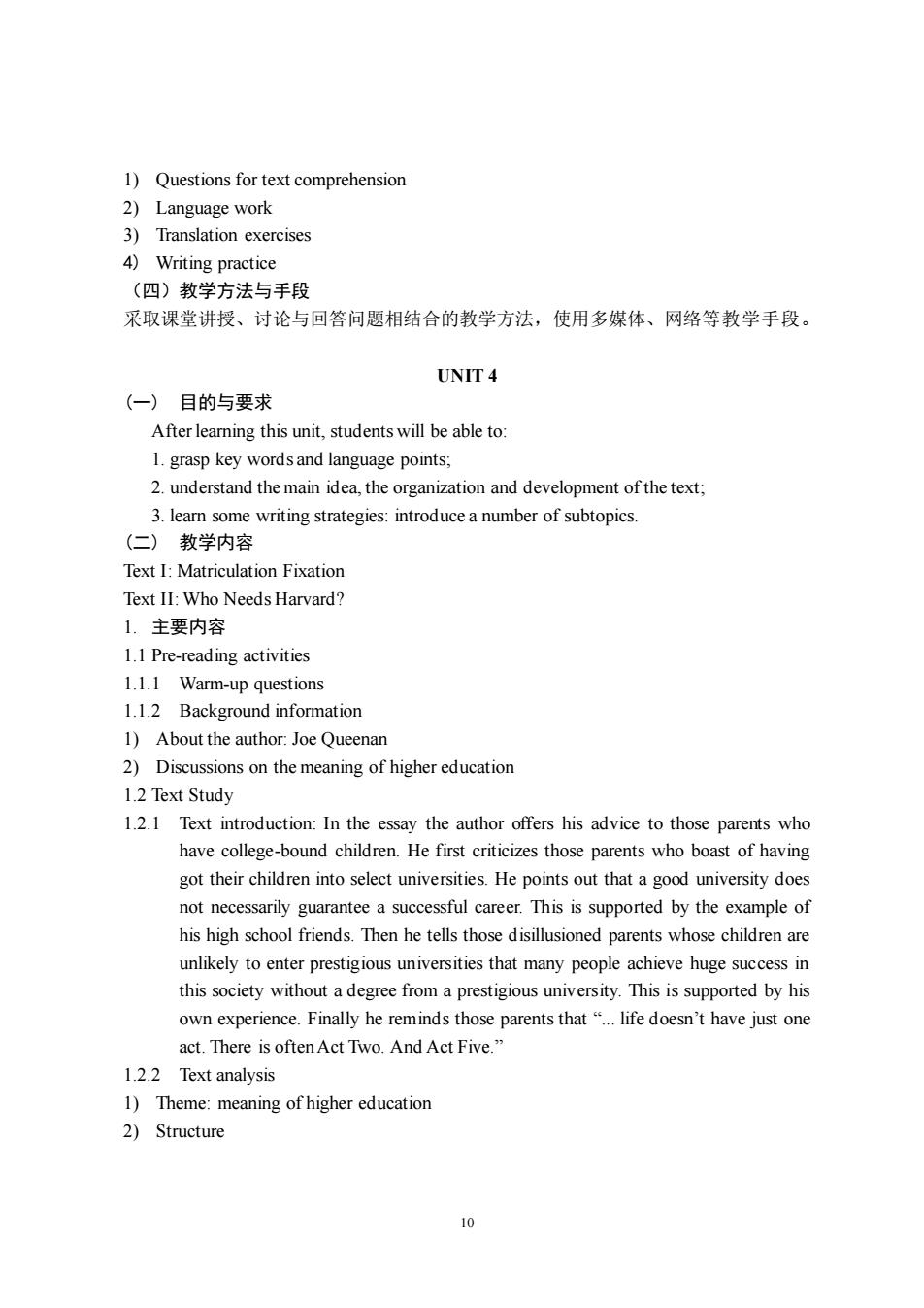
1)Questions for text comprehension 2)Language work 3)Translation exercises 4)Writing practice (四)教学方法与手段 采取课堂讲授、讨论与回答问题相结合的教学方法,使用多媒体、网络等教学手段。 UNIT4 (一)目的与要求 After learning this unit.students will be able to 1.grasp key wordsand language points. 2.understand the main idea,the organization and development of the text; 3.leamn some writing strategies:introduce a number of subtopics (二)教学内容 Text I:Matriculation Fixation Text II:Who Needs Harvard? 1.主要内容 1.1 Pre-reading activities 1.1.1 Warm-up questions 1.1.2 Background information 1)About the author:Joe Queenan 2)Discussions on the meaning of higher education 1.2 Text Study 1.2.1 Text introduction:In the essay the author offers his advice to those parents who have college-bound children.He first criticizes those parents who boast of having got their children into select universities.He points out that a good university does not necessarily guarantee a successful career.This is supported by the example of his high school friends.Then he tells those disillusioned parents whose children are unlikely to enter prestigious universities that many people achieve huge success in this society without a degree from a prestigious university.This is supported by his own experience.Finally he reminds those parents that"life doesn't have just one act.There is often Act Two.And Act Five." 1.2.2 Text analysis 1)Theme:meaning of higher education 2)Structure 10
10 1) Questions for text comprehension 2) Language work 3) Translation exercises 4) Writing practice (四)教学方法与手段 采取课堂讲授、讨论与回答问题相结合的教学方法,使用多媒体、网络等教学手段。 UNIT 4 (一) 目的与要求 After learning this unit, students will be able to: 1. grasp key words and language points; 2. understand the main idea, the organization and development of the text; 3. learn some writing strategies: introduce a number of subtopics. (二) 教学内容 Text I: Matriculation Fixation Text II: Who Needs Harvard? 1. 主要内容 1.1 Pre-reading activities 1.1.1 Warm-up questions 1.1.2 Background information 1) About the author: Joe Queenan 2) Discussions on the meaning of higher education 1.2 Text Study 1.2.1 Text introduction: In the essay the author offers his advice to those parents who have college-bound children. He first criticizes those parents who boast of having got their children into select universities. He points out that a good university does not necessarily guarantee a successful career. This is supported by the example of his high school friends. Then he tells those disillusioned parents whose children are unlikely to enter prestigious universities that many people achieve huge success in this society without a degree from a prestigious university. This is supported by his own experience. Finally he reminds those parents that “... life doesn’t have just one act. There is often Act Two. And Act Five.” 1.2.2 Text analysis 1) Theme: meaning of higher education 2) Structure